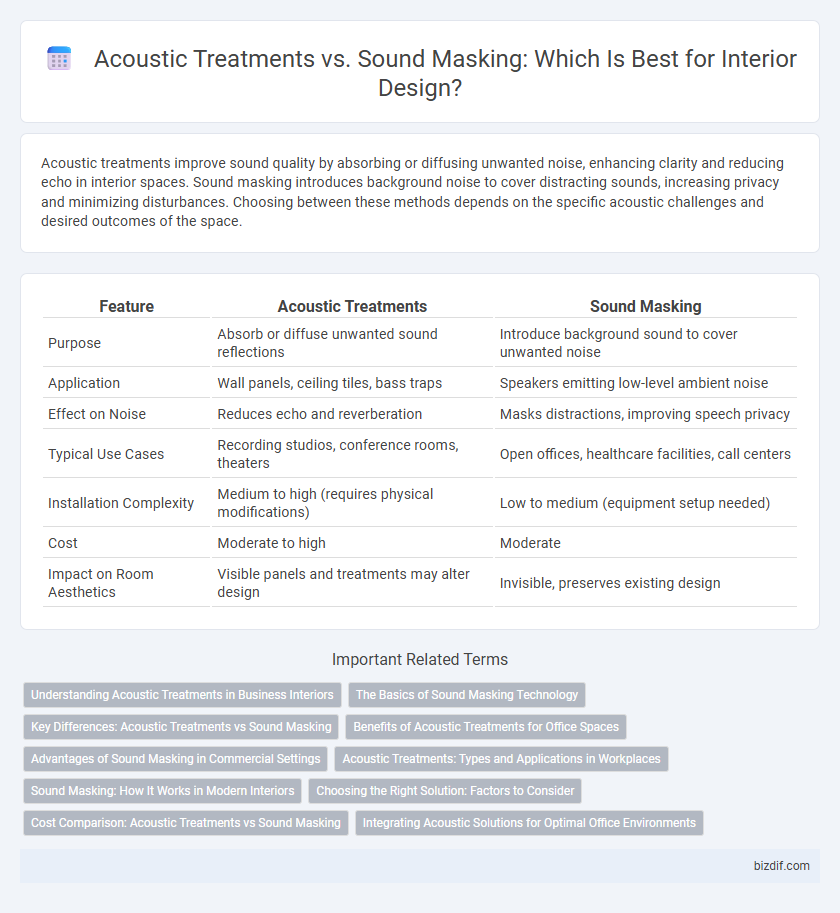Acoustic treatments improve sound quality by absorbing or diffusing unwanted noise, enhancing clarity and reducing echo in interior spaces. Sound masking introduces background noise to cover distracting sounds, increasing privacy and minimizing disturbances. Choosing between these methods depends on the specific acoustic challenges and desired outcomes of the space.
Table of Comparison
| Feature | Acoustic Treatments | Sound Masking |
|---|---|---|
| Purpose | Absorb or diffuse unwanted sound reflections | Introduce background sound to cover unwanted noise |
| Application | Wall panels, ceiling tiles, bass traps | Speakers emitting low-level ambient noise |
| Effect on Noise | Reduces echo and reverberation | Masks distractions, improving speech privacy |
| Typical Use Cases | Recording studios, conference rooms, theaters | Open offices, healthcare facilities, call centers |
| Installation Complexity | Medium to high (requires physical modifications) | Low to medium (equipment setup needed) |
| Cost | Moderate to high | Moderate |
| Impact on Room Aesthetics | Visible panels and treatments may alter design | Invisible, preserves existing design |
Understanding Acoustic Treatments in Business Interiors
Acoustic treatments in business interiors involve the strategic use of materials like acoustic panels, ceiling tiles, and diffusers to absorb and control sound reflections, improving speech clarity and reducing noise distractions. These treatments target specific problem areas by managing reverberation and echo, enhancing overall acoustic comfort for employees and clients. Unlike sound masking, which introduces background noise to cover unwanted sounds, acoustic treatments focus on modifying the physical environment to minimize noise at the source.
The Basics of Sound Masking Technology
Sound masking technology involves the strategic introduction of a low-level background sound designed to reduce distractions and enhance speech privacy within interior spaces. Unlike acoustic treatments that absorb or block sound waves to control reverberation and noise, sound masking systems emit consistent ambient noise, such as white or pink noise, to cover unwanted sounds effectively. This technology is essential in open office layouts, healthcare facilities, and hospitality environments to maintain a comfortable acoustic atmosphere while improving concentration and confidentiality.
Key Differences: Acoustic Treatments vs Sound Masking
Acoustic treatments improve sound quality by absorbing or diffusing noise within a space, reducing echoes and reverberation, while sound masking introduces controlled background noise to cover unwanted sounds and enhance speech privacy. Acoustic panels, bass traps, and diffusers are typical materials used for acoustic treatments, targeting specific frequency ranges to balance the room's acoustics. Sound masking systems employ speakers emitting white noise or ambient sounds, making them ideal for open offices or healthcare settings where reducing distractions and ensuring confidentiality is critical.
Benefits of Acoustic Treatments for Office Spaces
Acoustic treatments in office spaces enhance speech clarity and reduce noise distractions by absorbing and diffusing sound waves, leading to improved employee concentration and productivity. These treatments, including acoustic panels, ceiling clouds, and bass traps, effectively minimize reverberation and echo, creating a more comfortable and professional environment. By controlling sound, acoustic treatments also support privacy and reduce stress, contributing to overall workplace wellness.
Advantages of Sound Masking in Commercial Settings
Sound masking enhances speech privacy and reduces distractions in open office environments by introducing low-level background noise tailored to the space's acoustic profile. It preserves speech intelligibility while minimizing the impact of disruptive conversations or noises, promoting employee focus and productivity. Implementing sound masking systems can be more cost-effective and less intrusive compared to extensive acoustic treatments, making it ideal for commercial settings seeking flexible sound management solutions.
Acoustic Treatments: Types and Applications in Workplaces
Acoustic treatments in workplaces primarily include absorptive panels, diffusers, and bass traps designed to control sound reflections and reduce noise levels. These treatments improve speech intelligibility, reduce echo, and enhance overall acoustic comfort, making them ideal for open offices, conference rooms, and collaborative spaces. Proper application of acoustic materials, such as fabric-wrapped panels or ceiling clouds, directly contributes to increased productivity and employee well-being by creating a quieter work environment.
Sound Masking: How It Works in Modern Interiors
Sound masking involves adding a low-level background noise, usually white or pink noise, to reduce the intelligibility of speech and enhance acoustic privacy in modern interiors. This technique helps to minimize distractions and create a more comfortable environment in open-office layouts, healthcare facilities, and hospitality spaces by effectively blending unwanted sounds into the ambient background. Implementing advanced sound masking systems can improve speech privacy without altering room aesthetics or requiring extensive structural changes.
Choosing the Right Solution: Factors to Consider
Choosing the right solution between acoustic treatments and sound masking depends on the primary goal: acoustic treatments improve sound quality by absorbing or diffusing sound waves to reduce echo and noise, while sound masking adds background noise to cover unwanted sounds. Factors such as room size, purpose, budget, and the existing noise environment play crucial roles in decision-making. Understanding the specific acoustic challenges and desired outcomes ensures the most effective strategy for creating a comfortable and functional interior space.
Cost Comparison: Acoustic Treatments vs Sound Masking
Acoustic treatments typically involve higher upfront costs due to materials like foam panels, bass traps, and professional installation, ranging from $5 to $30 per square foot depending on quality and coverage. Sound masking systems generally have lower initial expenses, averaging $1 to $3 per square foot, but may incur ongoing maintenance and subscription fees for ambient noise generation. Comparing both options reveals that acoustic treatments provide a long-term, passive solution with higher capital investment, while sound masking offers a cost-effective, flexible approach with recurring operational costs.
Integrating Acoustic Solutions for Optimal Office Environments
Effective office environments integrate acoustic treatments and sound masking to enhance speech clarity and reduce noise distractions. Acoustic treatments use materials like panels, diffusers, and bass traps to absorb and control sound reflections, improving room acoustics. Sound masking systems generate background noise that masks disruptive sounds, promoting concentration and privacy in open-plan offices.
Acoustic Treatments vs Sound Masking Infographic

 bizdif.com
bizdif.com